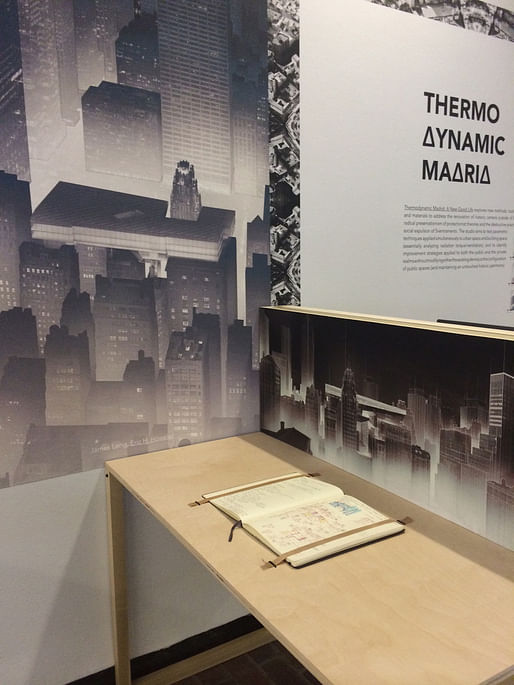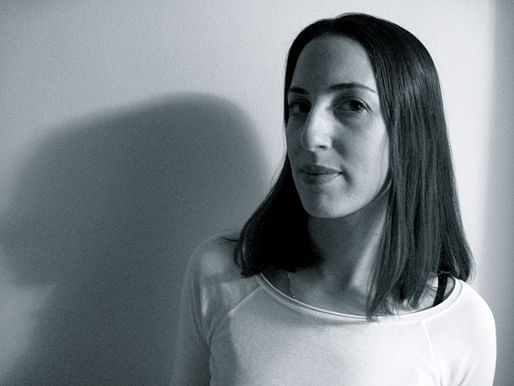

[Image from Pimentel.]
“You will be remembered for what you leave out or neglect.”
Rosetta Elkin, Editor of Platform 6, includes these words in a short meta-essay entitled “Editing Pedagogy,” in which she retroactively imagines a brief for the project of gathering, selecting, and representing a year in the work and life of Harvard GSD. It’s a provocative phrase, and when I came across it I pondered its many meanings.

[Wallpapered graphic in the Platform 6 exhibition]

[Strengthen your core! Third semester architecture in the Platform 6 exhibition]
First, I thought, it’s a nod to the difficult task of being the “decider” among critics, professors, and students clamoring to have their work, ideas, or events included in the school’s annual publication of record. The book doesn’t have space for coverage of every studio, let alone every course, essay, or project. Those who are left out inevitably take note.
Second, Elkin is highlighting the structural peculiarity of this year’s edition: Platform 6 has no index, no table of contents, no color-coded key words signaling the year’s trends in jargon. There’s nothing explicit telling me what to think or how to interpret the selection of projects. Even the most eye-catching move in the book’s organization is, purposefully, retiring: five faculty essays are inserted at intervals throughout the colorful, glossy book as a staid text printed on green paper, with a narrower trim size than the rest. Organizationally, Platform 6 is a major departure.
Third—most interesting to me, and explanatory of the first two points—the contents of this book speak judiciously in terms of what it excludes. It’s a lively, transitional period for the school, and for those looking for an indicator of where the GSD is at in terms of agendas both robust and tentative, Platform 6 delivers in spades.

[Entry graphic in the Platform 6 exhibition]

[Image from Pimentel.]
Looking at the book, it strikes me that it’s not only the sixth issue of Platform, but six years since Dean Mostafavi began his deanship. This period of time has particular significance for me, because my experiences at the GSD—from wide-eyed prospective to droopy-eyed first-year, and now, as an alumna—have spanned these same six years. I met Dean Mostafavi in his office in spring 2008, when I first visited Gund Hall and he was still unpacking books in his office. That same spring, Preston Scott Cohen, who finished his term as Chair of Architecture this past summer, was appointed; spring 2009, Charles Waldheim was tapped for Chair of Landscape Architecture; spring 2010, Rahul Mehrotra was named as Chair of Urban Planning and Design; and in 2011, Ben Prosky came on board as Assistant Dean of Communications, to consolidate and advance the school’s public facing efforts. Sometime in the following year, Iñaki Ábalos's name began to surface around Gund Hall as the next architecture chair, and he officially began his tenure this past fall.

[Work from one of the core architecture studios, in the Platform 6 exhibition]
As an alumna, I’m looking at the most recent edition of Platform as a guide to all of these changes in the school. So, even in Ciro Najle’s opening salvo of “extraordinarily large urban typologies,” I recall that Dean Mostafavi told Architectural Record in 2007 that one of his ambitions for his deanship was to consider the role of architecture at “a larger scale by engaging territories and regions instead of single buildings.” In Alexander Arroyo’s sublime thesis project on snow, operating at “the fragile interface between the geologic and meteorologic,” I see that the infrastructural approach to landscape promoted by Waldheim, along with other landscape faculty such as Chris Reed and Pierre Bélanger, has taken root and grown in sophistication.

[image from Vimeo]
The shout-out to thermodynamics at the end of Arroyo’s text calls the installation of Iñaki Ábalos as the chair architecture to mind. Although Ábalos has only officially been in place since July 2013--after the work for this issue of Platform was complete--he has been a presence in the school for a few years, and unofficially but widely understood to be the incoming chair for around a year or two. As such, Platform 6 already registers the influence of his agenda on thermodynamics as a dynamic approach towards sustainability, building technologies, and aesthetics. James Leng’s startlingly beautiful thesis proposing a “platform for energy exchange,” at once dry and monstrous, also signals this thermodynamic turn, as does the prominent interview with recent architecture faculty hire Kiel Moe.

[James Leng's thesis in the Platform 6 exhibition, with Ábalos's Thermo Dynamic Madrid peeking over his shoulder]
More generally, an incredibly eclectic series of projects represent the architecture department, ranging from Dasha Ortenberg’s blue-sky meditation on the design process; to John Todd’s philosophical and Japanese-inflected take on housing; Kevin Lamyuktseung’s witty “absence of style”; Savinien Caracostea’s hallucinatory cinematic spaces; Sara Tavakoli’s macabre dollhouse; and Lap Chi Kwong’s uncanny cut of a suburban house. It’s a greater level of diversity than I’ve seen from the department in Platform, and to me it’s a testament to my classmates’ abilities to learn from and synthesize diverse and divergent agendas, to create something new while running at full speed. Bravo to all of you.

[Successive chairs of architecture. Photo from my live blog coverage of the event.]

[Havard faculty members as paparazzi. Photo from my live blog coverage of the event.]
In the midst of all this, Preston Scott Cohen’s epic and very meta lecture, “Successive Architecture,” is documented with excerpts from his talk and a photo with seven successive chairs of the GSD’s architecture department. The text and photos are good, but here I recommend that you look up the YouTube video, which includes Dean Mostafavi’s opening thoughts on the school’s history, Cohen’s grand and winking performance, and finally—well, just watch it to the end.

[The exhibition tables are set up like student desks in Gund Hall's trays]
Back to Platform 6. Elkin stakes out “metacognition—how information is administered and processed” as her central territory in Platform 6, and the book achieves this in frustrating, but fascinating ways. In her foreword, she riffs on the value of studio-based learning and presents the book as a document of the exchanges between students and faculty at desk crits. While the work presented is in most cases much more polished than what one might find at a typical desk crit (with a few exceptions, such as a beguiling series of labyrinth sketches from a first-year student on p.129), Platform 6 succeeds in recreating the serendipitous and immersive feeling of wandering through the trays, catching glimpses of diverse projects, desk after desk.

An idiosyncratic weaving of voices in the book, with diverse texts sharing space on the same page, feeds this impression, as does the physical exhibition currently in Gund Hall, which is based on a charming yet unsettling reduced-scale model of the GSD’s studio desks.
In sum, the book’s main structural move, of withholding any navigational devices such as an index or table of contents, is as maddening as it is effective—and I know I’ll return to get lost in this book whenever I feel nostalgic for the hubbub of the studio spaces on Gund Hall’s trays.
Platform 6 is available for purchase online and the exhibition is now on view in Gund Hall.

[Rosetta Elkin, Editor of Platform 6; image from the GSD]
This blog was most active from 2009-2013. Writing about my experiences and life at Harvard GSD started out as a way for me to process my experiences as an M.Arch.I student, and evolved into a record of the intellectual and cultural life of the Cambridge architecture (and to a lesser extent, design/technology) community, through live-blogs. These days, I work as a data storyteller (and blogger at Littldata.com) in San Francisco, and still post here once in a while.



No Comments
Block this user
Are you sure you want to block this user and hide all related comments throughout the site?
Archinect
This is your first comment on Archinect. Your comment will be visible once approved.